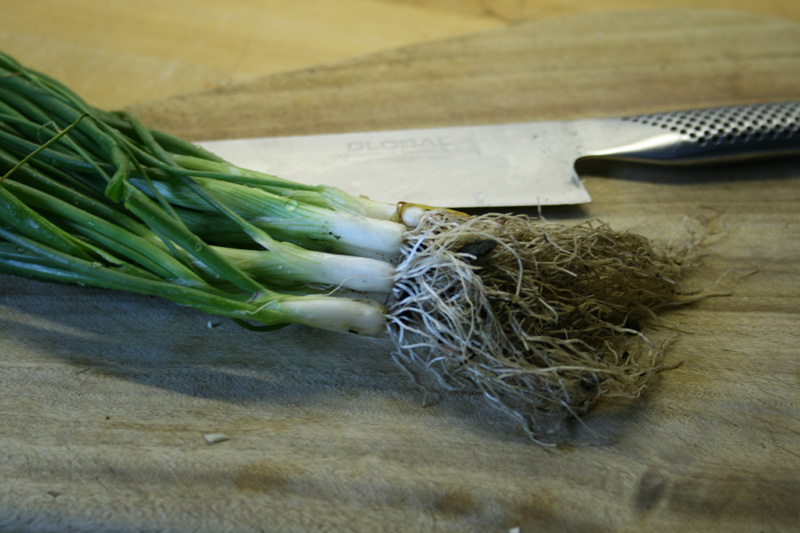
May 20, 2011
A good way to use this week’s spring onions and some spring greens – from Nigel Slater’s Tender (Vol. 1). As he says, ‘Of all the flavours that seem to bring out the best of the cabbage family’s earthy greenness, few work as effectively as those of Southeast Asia. Ginger, spring onion and garlic have a natural affinity with chlorophyll-rich vegetables of any sort …’
Serves 2 as a side dish
Preparation and cooking: about 15 minutes
Ingredients
about 12 stems or small leaves of chinese greens or small cabbage leaves
2 large cloves garlic
thumb-sized piece of ginger
6 spring onions (though maybe a few more of our CSA baby ones)
2 tbsp groundnut oil
1 tbsp nam pla (Thai fish sauce)
Method
Put a saucepan of deep water on to boil and salt it slightly. Wash the greens thoroughly. Peel the garlic and ginger, finely chop the garlic and shred the ginger into matchstick strips. Trim the spring onions and cut each into two or three.
Warm the oil in a shallow pan or wok. Toss the garlic, ginger and spring onions in the oil till deep gold, verging on being lightly browned and fragrant. Drop the greens, whole or shredded as you wish into the boiling water. Leave for only a minute or so before draining. Pour the fish sauce in with the garlic and ginger – it will spit and sizzle – then toss with the greens and eat.
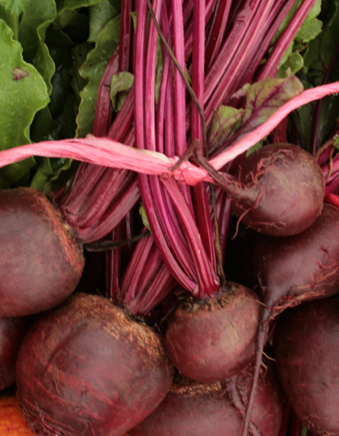
May 19, 2011
There’s an impressive amount of our own Camel CSA produce in this week’s vegetable boxes. Our first new polytunnel is enabling us to grow early crops to help fill the annual “hungry gap“.
We’ve also got the first Cornish new potatoes from Mark Norman, one of our three expert growers. And more delicious Cornish strawberries from a farmer near Hayle. So everyone will be having:
* lettuce leaf salad bag (Camel CSA)
* beetroot (Camel CSA)
* spring onions (Camel CSA)
* 500g Cornish new potatoes (Mark Norman)
Cornish strawberries (Growfair, Cornwall)
Standard boxes will also have:
* extra 250g Cornish new potatoes (Mark)
extra punnet of Cornish strawberries (Growfair)
* spring greens (Camel CSA)
* radish (Camel CSA)
* = grown to organic principles

May 13, 2011
An Edwardian dish (great name!) that Sarah Raven says was included in her aunt Fortune Stanley’s 1974 cookery book, English Country House Cooking. Sarah reproduces it in her Garden Cookbook. She says that with a crunchy salad of bitter leaves – our own Camel CSA-grown salad leaves would work well – it’s perfect for a light main course.
Serves 4
Preparation and cooking: 40 minutes
Ingredients
1 large cauliflower
175g butter, plus a little more for the dish
3 tbsp flour
6 tbsp single cream
250g strong cheddar cheese
salt and black pepper
1 tbsp mustard
6 eggs, separated
Method
Preheat a moderate oven (180C/gas 4). Divide the cauliflower into chunks and steam it for 3-4 minutes. Put the cauliflower in the bottom of a buttered souffle dish.
Melt the butter, add the flour and stir over a gentle heat for 1-2 minutes. Add the cream and cheese. Season and add the mustard and cook for 3-4 minutes, stirring continuously until the mixture thickens to the consistency of double cream. Take off the heat and stir in the egg yolks.
Whisk the egg whites and fold in. Pour the souffle mixture over the cauliflower and bake in the preheated oven for about 15 minutes, until the top is browned and risen.
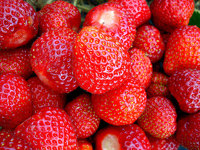
This week all boxes will have:
* salad (Camel CSA)
potatoes (Burlerrow Farm, St Mabyn)
spring greens (Mark Norman and Restharrow Farm, Trebetherick)
cauliflower (Restharrow Farm)
strawberries (Growfair, Cornwall)
Standard boxes will also have:
leeks (Growfair)
rhubarb (Mark Norman and CSA member Kitty Hotchkiss)
FRIDAY MORNING UPDATE : the packers found they needed to clear crops in the polytunnel – lettuces and spring onions. So, in addition to the above list, standard boxes had a lettuce and the small boxes had spring onions. Any surpluses were placed by a board saying help yourself (first come, first served).
* = grown to organic principles
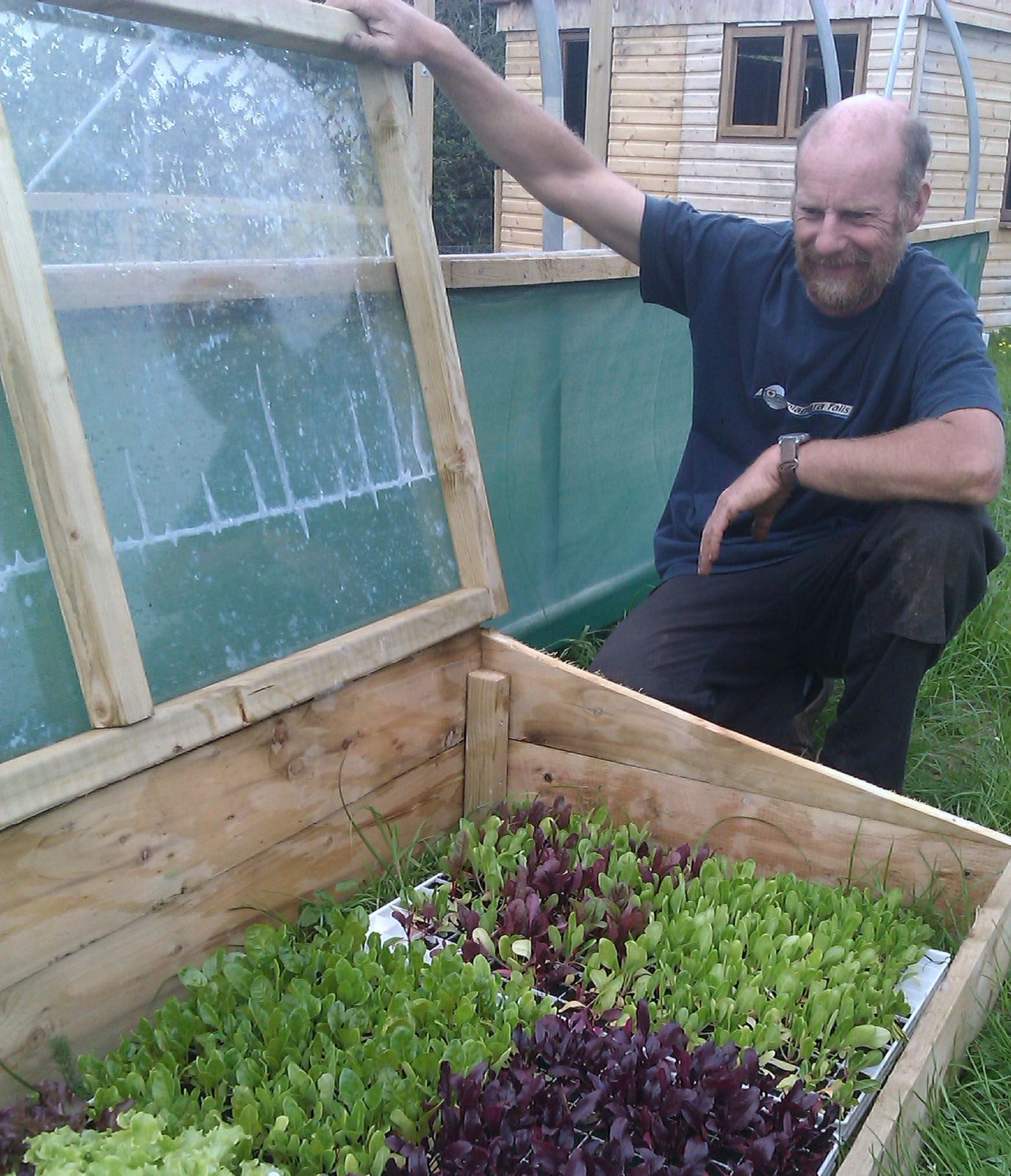
May 11, 2011
Cornish growers have experienced weather conditions ranging from drought to monsoon in a matter of days. Our own team has been alternately watering thirsty crops and wading through sticky mud.
The extended dry spell in Cornwall means we’re a little behind with some tasks. However the recent rain has enabled us to sow more peas, beans, parsnips, radishes, beetroot and carrot directly into the ground and plant out broccoli, cabbage, bunched onions, Swiss chard, lettuces, turnips and parsley.
The kohlrabi hasn’t germinated well outdoors, so we’re about to sow some in modules, along with more cabbage, Brussels sprouts, calabrese, celeriac and purple sprouting broccoli. We’ve also sown hundreds of winter squash seeds.

Salad leaves, french beans, leek seedlings, spring onions and baby beetroot are thriving in the polytunnel, though the indoor carrots aren’t doing so well.
Camel CSA’s weekly veg boxes rely heavily at this time of year on fresh supplies bought in directly from other local farmers and growers who’ve built up strong relationships with us. This mutually beneficial approach is all part of being a CSA.
They include Cornish asparagus produced by the Derrymans at Lower Croan, Sladesbridge; cauliflower and spring greens from Richard Hore of Restharrow Farm, Trebetherick; leeks and spinach from Jeremy Brown of St Kew Harvest; potatoes from Johnny Brown of Benbole Farm, St Kew Highway and James Mutton of Burlerrow, St Mabyn; rhubarb and mung beans (sprouted in his linen cupboard!) from Mark Norman in Bodmin.

In the aftermath of a long, hard winter it’s become more and more difficult to source fresh, seasonal veg grown within this 10-mile radius. When forced to cast our net county-wide we buy from Growfair Cornwall. But at least we’ve kept this side of the Tamar!
Fortunately our own early salad crops are sprouting fast.
Our volunteer picking and packing team spend some time every Friday morning cutting individual lettuce leaves from the polytunnel and outdoor-grown oriental greens – including spicy mustard, mizuna and mibuna – before bagging them up for the boxes.
The other immediate jobs involve covering the second polytunnel to house the tomatoes, completing the small seeding tunnel and getting the roof and windows finished on the potting shed.
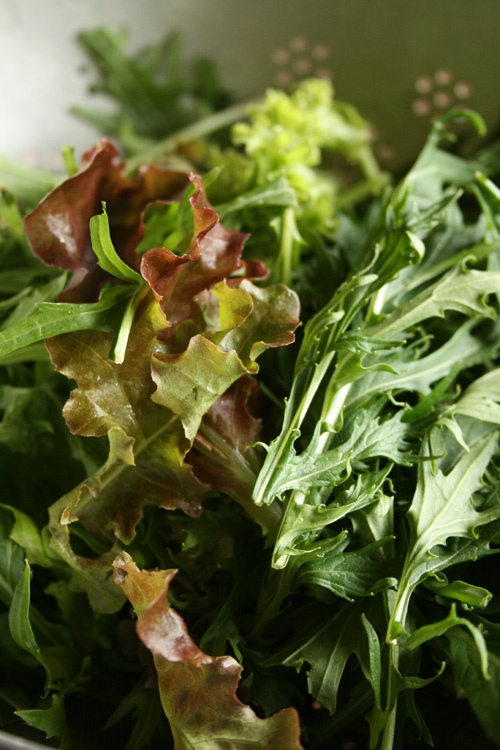
May 6, 2011
From Nigel Slater on the Royal Horticultural Society’s ‘Grow Your Own‘ website, in the ‘Eating and Cooking‘ section’ – the ideal recipe for the selection of Camel CSA’s own leaves in this week’s boxes.
Serves 4
Preparation and cooking: 15 minutes
Ingredients
200g piece of pancetta or bacon
2 thick slices of bread, crusts removed
a little olive oil
For the salad:
4 handfuls of leaves to include soft, mild lettuce and a spicier leaf such as one of the mustard family
a small bunch of flat leaf parsley
6 bushy sprigs of tarragon
about 10 basil leaves
For the dressing:
1 tbsp tarragon vinegar
2 tbsp olive oil
1 tbsp walnut oil
a dab of French mustard
Method
Cut the pancetta into small dice and tear the bread into larger pieces. Cook the pancetta in a shallow pan with a little oil until the fat is golden, then lift it out and drain on kitchen paper.
Using both the fat remaining in the pan and a little more oil if needs be, cook the bread cubes until they are golden on all sides. Watch them carefully, they can burn quite easily. Put them on kitchen paper to drain.
Rinse the leaves carefully, so as not to damage any of the fragile leaves. They are best dried in a salad spinner. Pull the leaves from the herb branches, tear the basil roughly and chop the others.
Make the dressing by mixing all the ingredients together with a small whisk or by shaking them in a jar. Toss the warm bacon and croutons of bread with the salad leaves, herbs and the dressing. Serve straight away …
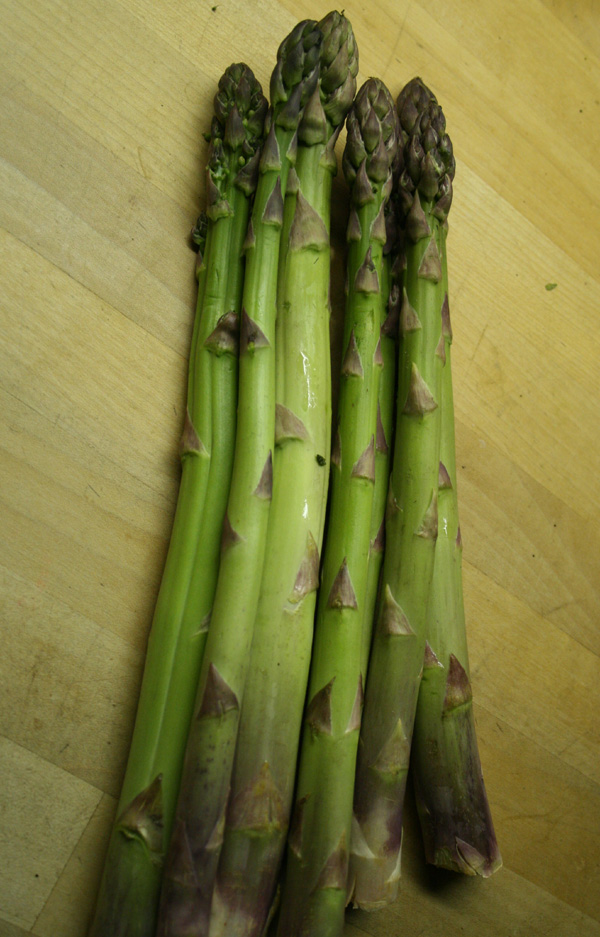
May 5, 2011
Expert grower Jane Mellowship reports that she’s ‘having the hardest time yet filling the boxes with Cornwall grown contents.’ Sadly, the Cornish rhubarb she’d hoped to get hold of is not available. Hopefully, she says, ‘standard box customers will understand when they get smaller boxes and realise that over the year the value of the contents does even out.’
Everyone will have:
* lettuce (Camel CSA)
* mixed salad bag (Camel CSA)
potatoes (Burlerrow Farm, St Mabyn)
cauliflower (Restharrow Farm, Trebetherick)
spring greens (Restharrow Farm)
asparagus (Lower Croan, Sladesbridge)
Standard boxes will have extra potatoes plus:
* leeks (Jeremy Brown, St Kew Harvest)
* sprouted mung beans (Mark Norman)
* = grown to organic principles
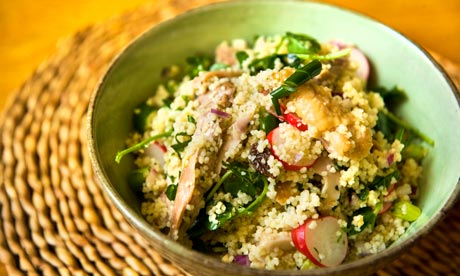
April 29, 2011
A variation on a recipe by Angela Hartnett that uses pea shoots but we can use the spinach from this week’s boxes instead. You can either cook the chicken from fresh or it’s an excellent way of using up some leftovers.
Serves 4 as a starter or 2 as a main
Preparation and cooking: 40 minutes or so if cooking the chicken, much less if not
Ingredients
olive oil
4 chicken thighs
salt and pepper
1 clove crushed garlic
1 sprig rosemary
250g instant couscous
400ml boiling water
2 spring onions, sliced
½ tsp ground ginger
1 dsp raisins
1 dsp chopped hazelnuts
4 salad radishes, sliced
50ml vinaigrette
½ tsp pesto
½ handful baby spinach or pea shoots
Method
Heat a touch of olive oil in a frying pan. Season the chicken with salt and pepper and cook together with the crushed garlic and rosemary over a medium heat for 15-20 minutes, turning occasionally until it is golden brown and a knife can go through it easily. If it appears to be dry, add a touch of water. Once it is cooked, allow it to cool and either shred the meat or remove the bone and slice into strips, skin and all.
While the chicken is cooling, turn your attention to the couscous. Place it in a bowl with a pinch of salt and 1 tbsp of olive oil, add the 400ml of boiling water, stir and cover with a plate or clingfilm. Leave for five minutes before removing the cover and breaking the couscous up with a fork. Then add the chicken and remaining ingredients. Mix well and check the seasoning.
Serve in a large bowl at room temperature.
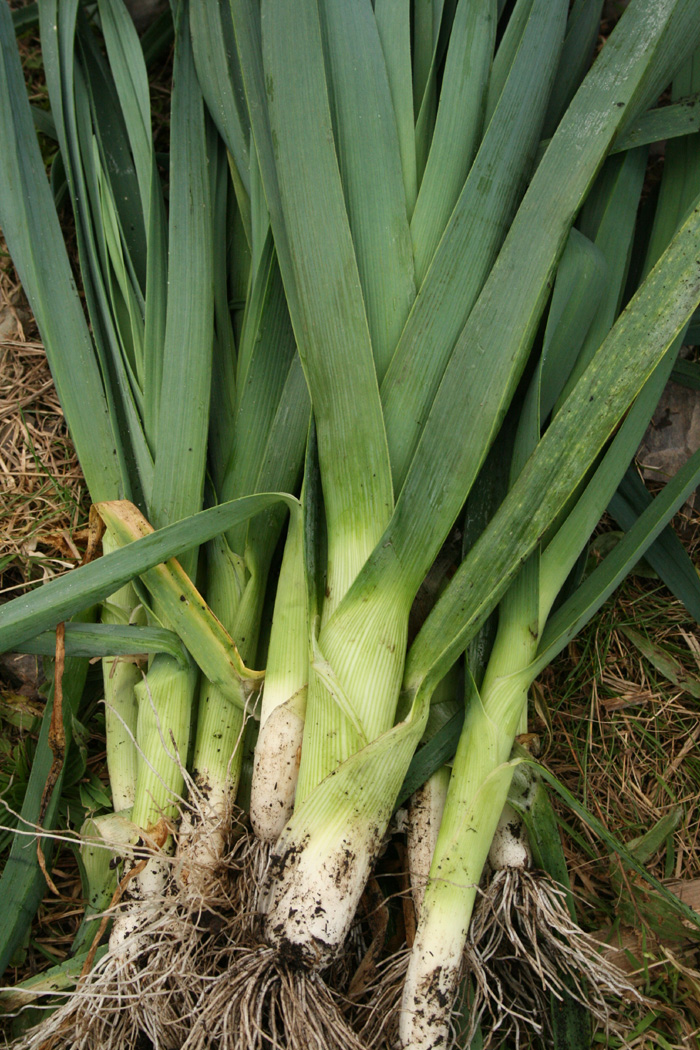
This week’s boxes will all look a bit smaller but the value is still there. Expert grower Jane Mellowship says:
There are so few local vegetables available at the moment I’ve had to include asparagus in the standard boxes even though it’s not cheap to buy, but we can’t keep adding extras as it would make it all rather expensive.
Of course, we have to remember that this is the hopefully brief “hungry gap” and what we are getting in our boxes is locally grown and certainly seasonal. The contents of this week’s generous salad bags were all grown on the Camel CSA plot and it was good to see young broad bean and pea plants appearing on the plot this morning in spite of the lack of rain. Good things to look forward to!
Everyone will have:
potatoes (Burlerrow Farm, St Mabyn)
* leeks (Jeremy Brown, St Kew Harvest)
* spring greens (Mark Norman)
* salad bags (Camel CSA)
* spinach (Jeremy)
Standard boxes will have extra potatoes plus:
asparagus (Lower Croan, Sladesbridge)
swede (Growfair, Cornwall)
* = grown to organic principles

April 27, 2011
The warm spring weather has brought on the asparagus crop in Cornwall. We’ve been enjoying Cornish asparagus from Lower Croan, Sladesbridge in our veg boxes for the past three weeks.
There’s a lot to be said for local food that’s come straight from the farm and run up few food miles.
Camel CSA is incredibly fortunate to be situated just a few fields away from the Derrymans’ asparagus farm. So it’s always tender and freshly picked – nothing like the tough old stalks you get in supermarkets.
Most of us would agree that asparagus is best eaten either on its own with some butter or hollandaise sauce, or with just a few simple extra ingredients.
Roger and Gill Derryman never get tired of their own Cornish asparagus with bacon and parmesan.
I’m a fan of what I call simply delicious Cornish asparagus with dry-cured bacon and a free-range poached egg (from my own hens, naturally).
Garden biographer Trish Gibson, who posts a recipe every week on this website, likes it even simpler – just Cornish asparagus with egg (from her hens).
Camel CSA volunteer Henrietta Danvers, who used to run her own restaurant in London, recommends Mark Hix’s more sophisticated shaved asparagus and goat’s cheese salad.
And if you’re not sure what to do with this lovely vegetable, why not begin with the basics: How to cook British asparagus.


